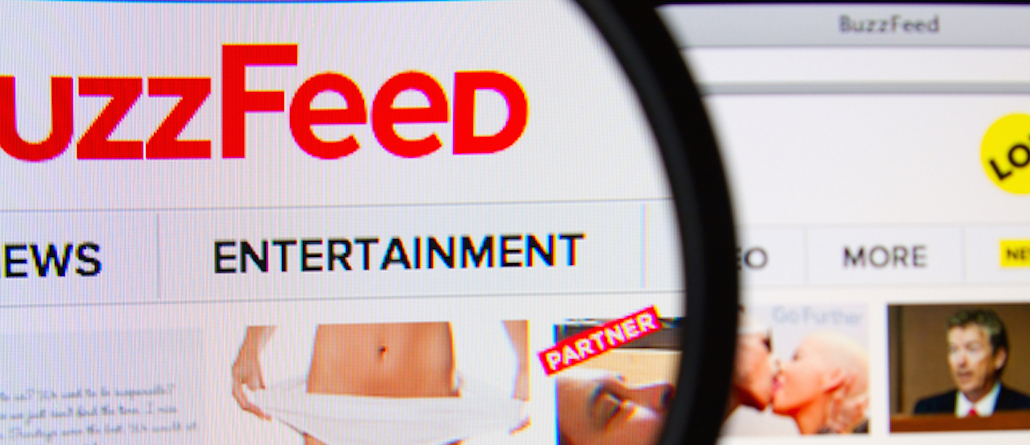BuzzFeed’s news is growing, but still a small part of its traffic

Over the years, BuzzFeed has labored hard to change its perception as a cat GIF and listicle farm. It hired star blogger Ben Smith away from Politico in 2011, who has brought on big-name journalists like Pulitzer-winner Mark Schoofs and Steve Kandell, and made a push into political and foreign news. In February, it did its first presidential interview when Smith sat down with Barack Obama.
In short, don’t tell Smith BuzzFeed is fluff: “Our mission’s to do great journalism and tell people about the world,” Smith proclaimed in an interview last year. Out of some 300 editorial staffers, 140 are devoted to news.
But if the viral perception still sticks, it’s not without reason. BuzzFeed drew 76.7 million multiplatform unique visitors in April, according to comScore. The publisher historically hasn’t broken out its content by vertical to comScore, like other top news sites including CNN, Yahoo and The Huffington Post do. But it started to on a limited basis as of last month, when it began breaking out its Entertainment and Life coverage, which stand at 43.7 million and 20.1 million uniques, respectively. BuzzFeed doesn’t break out its news traffic, suggesting it’s still relatively low.
Bottom line, BuzzFeed may have made headway a short time, but it is still a small player when it comes to news, in which it includes business, tech, politics and longform.
“You’ll hear clients say, ‘We want a BuzzFeed-style article,’” said Kim Alpert, director of digital strategy at Walton Isaacson. But when it comes to news, it hasn’t delivered a consistent product that’s instantly recognizable, she said. “Vice and Mashable, you kind of know what you’re going to get. I don’t believe their news has really matured in that people say, ‘I get my news from BuzzFeed.’”
With CEO Jonah Peretti recently hinting at going public, BuzzFeed could invite more scrutiny of its editorial model. BuzzFeed’s main revenue source is native advertising, a format that has been criticized for mimicking editorial. The publisher also has admitted taking down posts at advertisers’ requests.
The news traffic numbers may be small in Internet terms. But while BuzzFeed has mastered the art of the share and traditionally has measured success based on how much people share its content, news doesn’t always trigger the same reaction. With news, the goal is to be as impactful as possible, said Shani Hilton, executive editor for news. “We are extremely traditional in our news,” she said. “Sharing is still important in news stories, but it’s not the only thing.”
Asked for examples of stories that have made an impact, a BuzzFeed spokeswoman provided three. It said that Oklahoma Attorney General Admits “Error” In Brief To Supreme Court, But Says It Has No Bearing On Case led the AG to admit misleading the court about a lethal injection case. A second, Texas Sends Poor Teens To Adult Jail For Skipping School, led to one district suspending its truancy policy. A story investigating the foster case system, Fostering Profits, prompted a probe of the system, according to BuzzFeed.
BuzzFeed is one of the most high-profile examples of a native digital publisher expanding its editorial mandate to serious news, but other publishers, including The Huffington Post, Mashable and Refinery29 have followed this model. All feel the pressure to produce more content, keep people on site longer and attract more advertisers. News can give a site polish that can draw in premium advertisers.
Ben Kunz, vp of strategic planning at Mediassociates, said hard news can be a way for BuzzFeed to make inroads with an upscale, older audience that advertisers want, particularly as the election news cycle gathers reader attention. “You don’t sell a BMW to a millennial; you sell it to a 50-year-old,” he said. As for BuzzFeed’s relatively small news traffic, he added that the audience doesn’t have to be huge if they’re the right demo and engaged.
There are risks, though. News doesn’t have an endemic base of advertisers like lifestyle categories do. Some advertisers specifically avoid having their ad show up near hard news because of the potential for it to be controversial, though. As for readers, a challenge is that since people increasingly come to the news from search or social media today, they’re seeing it out of context. And if the hard news feels off-brand, the effect can be more jarring than engaging.
An earlier version of this story incorrectly stated that 17 percent BuzzFeed’s traffic was going to news. BuzzFeed has not broken out traffic to its news vertical to comScore, so exact figures are not yet available.
Image courtesy of BuzzFeed.
More in Media

Meta AI rolls out several enhancements across apps and websites with its newest Llama 3
Meta AI, which first debuted in September, also got a number of updates including ways to search for real-time information through integrations with Google and Bing.

Walmart rolls out a self-serve, supplier-driven insights connector
The retail giant paired its insights unit Luminate with Walmart Connect to help suppliers optimize for customer consumption, just in time for the holidays, explained the company’s CRO Seth Dallaire.

Research Briefing: BuzzFeed pivots business to AI media and tech as publishers increase use of AI
In this week’s Digiday+ Research Briefing, we examine BuzzFeed’s plans to pivot the business to an AI-driven tech and media company, how marketers’ use of X and ad spending has dropped dramatically, and how agency executives are fed up with Meta’s ad platform bugs and overcharges, as seen in recent data from Digiday+ Research.





